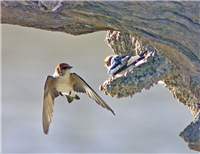Family
Hirundinidae
Genus
Hirundo
Species
ariel
Threats/Control Methods - Regional
Larger and more abundant bird species such as sparrows will destroy Fairy Martin nests, dominating them for nesting space and food. The Martin's preferred habitat in this region, the Yellow Box/Red Gum Grassy Woodland, is currently considered an Endangered Ecological Community.
Threats/Control Methods - Local
This species does not appear to have adapted well to the urban environment. Other introduced species such as the House Sparrow (Passer domesticus ) and domestic Cats (Felis catus) are well suited to the suburbs and threaten the Fairy Martin.
Local/Urban Actions
Taking action to revegetate the woodland areas around the ACT is the best way to ensure this species survives locally. Groups such as Landcare often facilitate plantings, or check Greening Australia for upcoming events and ways to get involved. Cat owners can consider keeping their pets in a stimulating indoor environment or installing a cat enclosure.
Common Names
Fairy Martin, Bottle Swallow, Cliff Swallow
Distinguishing Features
This small 12cm species has a tiny body with long tail and wing feathers. Its head is a cinnamon colour, with a little dark eye and a tiny dark bill. Its shoulder area is glossy blue-black with brown wings and tail feathers. The rump and underparts are white, with fine dark streaks across the neck. When watching the bird in flight from below, the tail looks square and the bird appears a creamy-brown colour. Young birds are duller.
Survey Techniques
Call and visual identification.
Species Call
A feeble, twittering song or an abrupt contact 'drrt, drrit' call.
Similar Species
The Tree Martin (Hirundo nigricans) is very similar in shape and size, with a glossy blue head and darker streaks on the light cheeks and underparts.
Distribution
Fairly Martins are found across Australia in fairly low numbers, with none found in the most arid areas or along the west coast of TAS. In winter months it can be found in Papua New Guinea.
Country of Origin
Australia
Conservation (Pet/Pest) Status - Regional
There has been a significant fall in population numbers, as it was always uncommon and is now extremely rare (Veerman).
Conservation (Pet/Pest) Status - National
Secure, not listed under the EPBC Act 1999.
LSCCES Population
One bird was seen on the ANU campus.
Associated vegetation community
Open country, with rock cliffs or caves is preferable, including woodland, grassland or eucalypt forest.
Limiting Resources
This speices needs to be close to a relaible water source and prefers open country.
Breeding
Fairly Martins breed throughout the year, usually from June to December. Breeding pairs build a very recognisable bottle shaped mud nests attached under bridges, rock ledges or in shallow caves. In areas where the breeding colony consists of many birds, the nests may be built on top of one another, with only the entrance hole visible. A clutch size is 4-5 birds, hatching from their white, brown-speckled eggs after 14-16 days of incubation.
Behaviour
This species is active and dependant on one-another, feeding and nesting in large groups or colonies. In breeding months, the colonies are very loud, with up to hundreds of birds calling, beginning before dawn. Their flight is fairly slow and fluttering. They visit the Canberra region in the summer months.
Functional Group
Food Species
Fairy Martins feed from large swarms of insects while in flight. They feed in large groups and high in the air.
Predators
Feral or domestic Cats (Felis catus) will hunt this small bird. Due to any shortage of nesting space, sparrows, pardalotes and Zebra Finches (Taeniopygia guttata) will destroy their nests.
Interesting Fact
Often the nest will be the only clue to show that Fairy Martins have been in the area, as they are fairly shy and inconspicuous to humans.
References - (reader suitability of references, P=Primary teachers, S=Secondary students, T=Tertiary students and researchers)
Books:Morcombe, M. 2000. Field Guide to Australian Birds. Steve Parish Publishing. Archerfield. Australia P, S, T
Pizzey, G. 2000. The Graham Pizzey & Frank Knight Field Guide to the Birds of Australia. Angus & Robertson, Sydney. P, S, T
Veerman, P. 2003. Canberra Birds: A report on the first 21 years of the garden bird survey. Philip Veerman and Canberra Ornithologists Group. Canberra. S, T
Internet: Birds in Backyards. 2006. [online]. Available at:http://www.birdsinbackyards.net P, S, T
Online Publications:ACT Government. 2004. Woodlands for Wildlife: ACT Lowland Woodland Conservation Strategy. Action Plan No. 27. Environment ACT, Canberra. [online]. Available at: http://www.environment.act.gov.au/nativeplantsandanimals/threatecspec/woodlandsstrategy S, T
Nix, H. and Cunningham, R. 2006. Birds of the Lower Sullivans Creek Catchment, Canberra ACT. Prepared for the Life in the Suburbs project using data from the Lower Sullivans Creek Catchment Ecological Survey (LSCCES). Australian National University. Canberra. [online]. Available at: http://www.lifeinthesuburbs.com.au/category.php?id=65 S, T

 Top
Top Top
Top